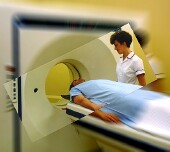
MONDAY, Nov. 29 (HealthDay News) — The use of CT scans as a diagnostic tool is surging in emergency departments across the United States, new research indicates.
In the 13-year period leading up to 2007, CT scan use in ERs increased by nearly sixfold, the study team found.
The trend has raised concerns about the potential risks posed by more frequent exposure to the ionizing radiation emitted by CT scanners, they added.
Ionizing radiation can cause cancer, and federal experts warn that one way to protect yourself is to avoid unnecessary medical X-rays. In fact, the study pointed out, CT scans represent the largest source of medically related exposure to ionizing radiation in the United States.
However, study author Dr. David B. Larson, director of quality improvement in the department of radiology at Cincinnati Children’s Hospital Medical Center in Cincinnati, said he was not surprised that CT use has been on the upswing in the nation’s ERs, given that it is “an extremely valuable tool.”
“But we found it remarkable that its use has increased so steadily and at such a high rate,” he said. “It is behaving as if it is still in the early stages of growth.”
Larson and his team report their observations in the Nov. 29 issue of Radiology. They are also slated to discuss the findings Monday at the annual meting of the Radiological Society of North America (RSNA), in Chicago.
CT scans are not, of course, a new technology, having been first introduced into hospital settings in the mid-1970s.
The current analysis focused on data collected by the National Hospital Ambulatory Medical Care Survey, which was conducted between 1995 and 2007.
By reviewing statistics covering more than 30,000 ER visits per year over the survey’s 13-year time-frame, Larson and his colleagues found that CT exams had rocketed upwards from just 2.7 million in 1995 to 16.2 million in 2007.
In 1995, in fact, only 2.8 percent of ER visits involved a CT scan, compared to 13.9 percent in 2007. This translates, the authors noted, into a 16 percent increase in usage per year.
If the trend continues, they said, one in five ER visits will involve a CT scan by 2011.
The authors also observed that the diagnostic impetus for enlisting the use of a CT scan has shifted. While in the past such scans have primarily been used for patients complaining of headaches, Larson and his associates found that by 2007 more patients were being scanned following a complaint of abdominal pain. Headache and chest pain were the next leading reasons for a CT scan.
That particular finding is noteworthy, given that abdominal scans typically entail exposure to higher levels of radiation than CT exams focused on a headache diagnosis. The study reported that although there has been a tenfold upsurge in ER visits involving CT scans since 1995, the estimated population radiation dose associated with these ER visits has jumped from 2259 Sv in 1995 to 50,937 Sv in 2007 — a whopping 23-fold increase. This suggests that higher-dose CT exams are rising much faster than lower-dose exams, the researchers cautioned.
Larson nevertheless stressed the benefits that a CT scan can provide to patients and physicians alike.
“It provides exquisitely detailed images of the body in a matter of a few seconds, and the technology just keeps improving,” he said.
“But,” Larson added, “the rapid growth emphasizes the need for more sophisticated strategies to ensure that it is being used appropriately.”
To that end, he suggested that CT scan use should be discussed on a case-by-case basis. “Often the decision is not straightforward,” he said, “and, when in doubt, it may be easier just to get the scan, now that CT is so widely available. In order to make sure that CT is used appropriately, we need to develop better methods of tailoring the evidence to each patient situation. This will be a challenge, but it is not insurmountable.”
Dr. Robert Zimmerman, an executive vice chair of radiology at Weill Cornell Medical Center in New York City, expressed little surprise at the apparent usage trends.
“It’s really well known that there’s been an explosive increase in the number of CT scans done in an emergency setting,” he noted. “Because it quickly became clear that for head trauma CT scans were superior to anything else we could do. So it took off, and we never looked back.”
Zimmerman noted that abdominal scanning in particular started to become more popular at the turn of this century, as scans became faster and easier to use. And he agrees with Larson that the technology is mostly a boon for medicine, albeit one that needs to be harnessed with caution.
“It’s certainly a positive thing that there are now ways of rapidly scanning peoples bodies and finding pathologies that wouldn’t have been found before,” he said. “It improves medical outcomes. But we need to control their utilization, and reduce the amount of radiation associated with these scanning exams to make sure they’re safe and people have confidence they are safe.”
“Every situation is different,” he concluded. “And patients have to keep in mind if they’ve had scans in the past, or know if they’re repeating something that’s already been done. Patients have to bring that to the table and discuss it with their attending physicians. But certainly, when appropriate, this kind of care needs to be done.”
More information
For more on CT scans, visit the RadiologyInfo.org.

